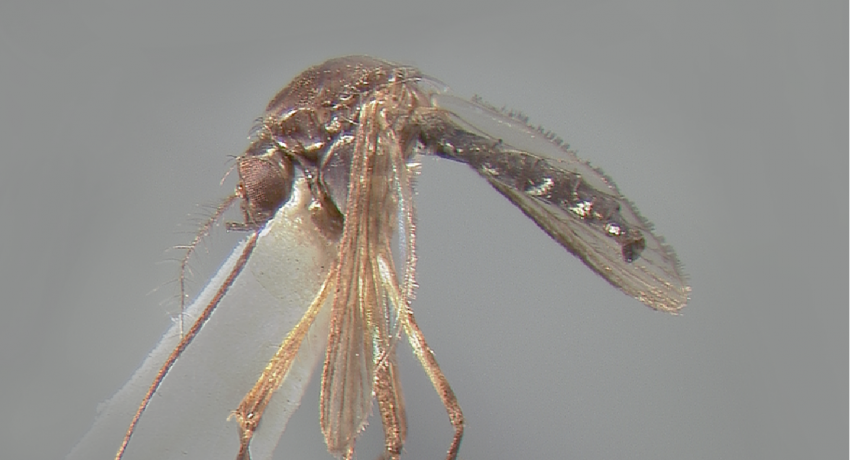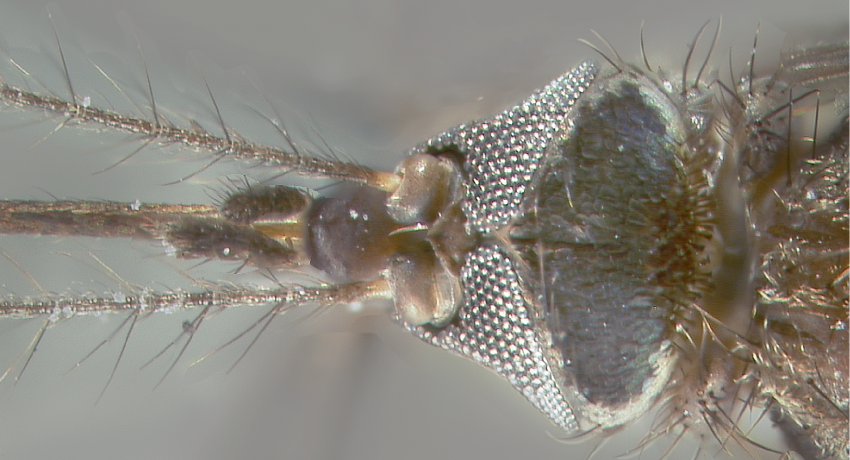AUSTRALASIA, ORIENTAL & PALEARCTIC REGIONS
Generic abbreviation: Ve.
Type species: Type species Aedes butleri Theobald
Etymology: not stated (probably for George Henry Verrall)
Species of the genus Verrallina are differentiated from all Aedines by the unique characters of their male and female genitalia. Verrallina comprises 95 species, further subdivided into three subgenera: Harbachius (13 species), Neomaclaya (52 species) and Verrallina (30 species). Verrallina species occur throughout the Oriental region north to Russia and Japan, and southeast into the Papuan Subregion and northeastern Australia.
DIAGNOSTIC CHARACTERS (Click photos to view; mouse over and click large photo to zoom in.)
ADULT (illustrated): Head: Decumbent scales of vertex broad. Thorax: Scutum with dorsocentral setae present; acrostichal setae sparse to numerous; all scutal and scutellar scales curved and narrow; mesopostnotum usually bare; paratergite without scales or setae; postpronotum bare or with all curved and narrow scales; prespiracular area bare; postspiracular setae present. Wing: Alula with fairly broad marginal scales. Leg: Ta-I–III dark-scaled.
LARVA (not illustrated): Head: Antenna with numerous spicules; characteristic position and form of setae 4–7-C, short and multi-branched; 5–7-C stout and about the same length; seta 11-C short and multi-branched. Thorax: Seta 8-P long and thickened. Abdomen: Seta 7-I long, 1–3 branched; seta 7-II short, branched. Terminal segments: Saddle incomplete; seta 4-X usually with 10 setae on a grid and 2–3 precratal setae; pecten with 6–20 pecten spines, with distal-most 5 more widely spaced.
TAXONOMIC KEYS
Laffoon 1946 (Philippines)
King & Hoogstraal 1947a (New Guinea)
Belkin 1962 (Papuan Subregion)
Delfinado 1967
Delfinado 1968
Huang 1968b (Papuan Subregion)
Lee et al. 1987b (Australasian Region)
Rattanarithikul & Harrison et al. 2005 (Thailand)
Rattanarithikul et al. 2010 (Thailand)
![]()
WRBU – Genera – Global – Larva
![]()
WRBU – Genera – Australasia – Adult
![]()
WRBU – Genera – Australasia – Larva
![]()
WRBU – Genera – IndoMalaya – Adult
![]()
WRBU – Genera – IndoMalaya – Larva
![]()
WRBU – Genera – Oriental – Adult
![]()
WRBU – Genera – Oriental – Larva
![]()
WRBU – Genera – Eastern Palearctic – Adult
![]()
WRBU – Genera – Eastern Palearctic – Larva
Exemplar DNA sequences
Ve (Har.) nobukonis COI: LC054379
Ve. (Nma.) indica COI: AY834245
Ve. (Nma.) pseudomediofasciata COI: EU259310
Ve. (Ver.) butleri COI: KF564665–69
Ve. (Ver.) funerea COI: MG712565–66.
Ve. (Ver.) lugubris COI: DQ424950, DQ424955-56, EU259290–91
BIONOMICS
Immatures
Habitats of Immature Verrallina are typically found in temporary jungle ground waters including flood pools, puddles, road ruts, or animal hoof prints. Species including Ve. butleri (Theobald) are found in coastal brackish water pools and swamps. Others inhabit natural containers including crabholes (Ve. clavata (Barraud), Ve. parasimilis (King & Hoogstraal), plant axils (Ve. uncus (Theobald)), and artificial container habitats including wells (Ve. vallistris (Barraud)) and tin cans (Ve. campylostylus (Laffoon)).
Adults
Typically jungle creatures, species of Verrallina are also found in coastal mangroves and bamboo groves. Females of several species will bite people in the shady jungle during the day, causing issues for loggers and palm oil plantation workers. in the South Pacific, Ve. carmenti (Edwards) and Ve. lineata (Taylor) are well-known nuisance biters, and these species and Ve. reesi (King & Hoogstraal) will enter homes to feed. Species of the subgenus Verrallina lay their eggs in areas prone to flooding. Uniquely among mosquitoes, Verrallina eggs are protected by gelatinous strings to prevent desiccation.
*Associated pathogens: This list reports bacteria, viruses, and parasites recovered from, or experimentally passed through this species, and does not imply field vector status.
IMPORTANT REFERENCES (full citations below)
Theobald 1903a: 295 (as genus, subgenus)
Bourroul 1904: 45 (synoptic table; incorrect spelling of Verrallina)
Blanchard 1905: 417
Leicester 1908: 196 (as genus)
Laffoon 1946: 228 (keys; Philippines)
King & Hoogstraal 1947a: 113 (keys; New Guinea)
Belkin 1962: 412 (from synonymy, keys; Papuan Subregion)
Delfinado 1967 (keys); Delfinado 1968 (keys)
Huang 1968a (Papuan Subregion)
Huang 1968b: 169 (subgeneric keys; Papuan Subregion)
Reinert 1974a (review; as subgenus of genus Aedes)
Reinert 1984 (taxonomy; Sri Lanka)
Lee et al. 1987b: 250 (taxonomic keys, bionomics, distribution; Australasian Region)
Reinert 1999c (to genus; taxonomy, classification)
Reinert 2001c (F gen); Reinert et al. 2004 (classification, phylogeny)
Rattanarithikul & Harrison et al. 2005 (F, L; keys, bionomics; Thailand)
Reinert et al. 2009 (classification, phylogeny)
Rattanarithikul et al. 2010 (keys, bionomics; Thailand)
Wilkerson et al. 2015 (phylogeny, classification)
Soghigian et al. 2017 (molecular phylogeny)
VALID SUBGENERA
Harbachius Reinert [Har.]
Neomacleaya Theobald [Nma.]
Verrallina Theobald [Ver.]
CURRENT GENERIC SYNONYMS
syn. Verralina Lutz 1904: 45 (synoptic table; incorrect spelling of Verrallina). In: Bourroul 1904.
CITED REFERENCES
Belkin, J.N. (1962). The mosquitoes of the South Pacific (Diptera, Culicidae) (Vols. 1 &2). Berkeley, California: University of California Press.
Blanchard, R. (1905). Les moustiques, histoire naturelle et médicale. F. R. de Rudeval, Imprimeur-Editeur, Paris. 673 pp.
Bourroul, C. (1904). Mosquitos do Brasil. Faculdade de Medicina da Bahia, 78pp.
Delfinado, M.D. (1967). Contributions to the mosquito fauna of Southeast Asia. I. The genus Aedes, subgenus Neomacleaya Theobald in Thailand. Contributions of the American Entomological Institute, 1(8), 1–56.
Delfinado, M.D. (1968). Contributions to the mosquito fauna of Southeast Asia. III. The genus Aedes, subgenus Neomacleaya Theobald in Southeast Asia. Contributions of the American Entomological Institute, 2(4), 1–74.
Huang, Y.-M. (1968a). Aedes (Verrallina) of the Papuan subregion (Diptera: Culicidae). Pacific Insects Monograph, 17, 1–73.
Huang, Y.-M. (1968b). A new subgenus of Aedes (Diptera, Culicidae) with illustrated key to the subgenera of the Papuan subregion (Diptera, Culicidae). Journal of Medical Entomology, 5, 169–188.
King, W.V., & Hoogstraal, H. (1947a). New Guinea species of mosquitoes of the genus Aedes, subgenus Aedes. Journal of the Washington Academy of Sciences, 37, 113–134.
Laffoon, J. (1946). The Philippine mosquitoes of the genus Aedes, subgenus Aedes. Journal of the Washington Academy of Sciences, 36, 228–245.
Lee, D.J., Hicks, M.M., Griffiths, M., Debenham, M.L., Bryan, J.H., Russell, R.C., . . . Marks, E.N. (1987b). The Culicidae of the Australasian region. Volume 5. Commonwealth Department of Health, School of Public Health and Tropical Medicine Monograph Series, 2.
Leicester, G.F. (1908). The Culicidae of Malaya. Studies from the Institute for Medical Research, Federated Malay States, 3(3), 18–261.
Rattanarithikul, R., Harbach, R.E., Harrison, B.A., Panthusiri, P., Coleman, R.E., & Richardson, J.H. (2010). Illustrated keys to the mosquitoes of Thailand VI. Tribe Aedini. Southeast Asian Journal of Tropical Medicine and Public Health, 41(1), 1–225.
Rattanarithikul, R., Harrison, B.A., Panthusiri, P., & Coleman, R.E. (2005). Illustrated keys to the mosquitoes of Thailand. I. Background; geographic distribution; lists of genera, subgenera, and species; and a key to the genera. Southeast Asian Journal of Tropical Medicine and Public Health, 36(1), 1–80.
Reinert, J.F. (1974a). A new intepretation of the subgenus Verrallina of the genus Aedes (Diptera: Culicidae). Contributions of the American Entomological Institute, 11(1), 1–249.
Reinert, J.F. (1984). Medical entomology studies - XVI. A review of the species of subgenus Verrallina, genus Aedes, from Sri Lanka and a revised description of the subgenus (Diptera: Culicidae). Mosquito Systematics, 16(1), 1–130.
Reinert, J.F. (1999c). Restoration of Verrallina to generic rank in tribe Aedini (Diptera: Culicidae) and descriptions of the genus and three included subgenera. Contributions of the American Entomological Institute, 31(3), 1–83.
Reinert, J.F. (2001c). Comparative anatomy of the female genitalia of genera and subgenera in tribe Aedini (Diptera: Culicidae). Part VIII. Genus Verrallina Theobald. Contributions of the American Entomological Institute, 32(4), 17–39.
Reinert, J.F., Harbach, R.E., & Kitching, I.J. (2004). Phylogeny and classification of Aedini (Diptera: Culicidae), based on morphological characters of all life stages. Zoological Journal of the Linnean Society, 142, 289–368.
Reinert, J.F., Harbach, R.E., & Kitching, I.J. (2009). Phylogeny and classification of tribe Aedini (Diptera: Culicidae). Zoological Journal of the Linnean Society, 157(4), 700–794.
Soghigian, J., Andreadis, T.G., & Livdahl, T.P. (2017). From ground pools to treeholes: convergent evolution of habitat and phenotype in Aedes mosquitoes. BMC Evolutionary Biology, 17, 262.
Theobald, F.V. (1903a). A monograph of the Culicidae of the World (Vol. 3). London: British Museum (Natural History). 359pp
Wilkerson, R.C., Linton, Y.-M., Fonseca, D., Schultz, T., Price, D., & Strickman, D. (2015). Making mosquito taxonomy useful: A stable classification of tribe Aedini that balances utility with current knowledge of evolutionary relationships. PLoS ONE, 10(7), e0133602.
CITE THIS PAGE
Walter Reed Biosystematics Unit (Year). Verrallina genus page. Walter Reed Biosystematics Unit Website, http://wrbu.si.edu/vectorspecies/genera/verrallina, accessed on [date (e.g. 03 February 2020) when you last viewed the site].






